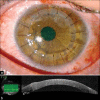Lamellar keratoplasty techniques
- PMID: 30127133
- PMCID: PMC6113816
- DOI: 10.4103/ijo.IJO_95_18
Lamellar keratoplasty techniques
Abstract
Lamellar keratoplasty (LK) has revolutionized corneal graft surgery in several ways. Deep anterior LK (DALK) has eliminated risk of failure due to endothelial rejection. Endothelial keratoplasty (EK) has almost eliminated induced astigmatism and the "weak" graft-host junction as seen with penetrating keratoplasty (PK) and also reduced the risk of endothelial rejection. LK provided new insights into posterior corneal anatomy that led to better understanding and performance of DALK and to the development of another EK procedure, namely pre-Descemet's EK (PDEK). Surgical procedures for LK were further refined based on the improved understanding and are able to deliver better surgical outcomes in terms of structural integrity and long-term patient satisfaction, reducing the need of further surgeries and minimizing patient discomfort. In most specialist centers, anterior lamellar techniques like DALK and EK techniques like Descemet's stripping EK (DSEK) and Descemet's membrane EK (DMEK) have replaced the full-thickness PK where possible. The introduction of microkeratome, femtosecond laser, and PDEK clamp have made LK techniques easier and more predictable and have led to the innovation of another LK procedure, namely Bowman membrane transplant (BMT). In this article, we discuss the evolution of different surgical techniques, their principles, main outcomes, and limitations. To date, experience with BMT is limited, but DALK has become the gold standard for anterior LK. The EK procedures too have undergone a rapid transition from DSEK to DMEK and PDEK emerging as a viable option. Ultrathin-DSEK may still have a role in modern EK.
Keywords: Deep anterior Lamellar keratoplasty; Descemet's membrane endothelial keratoplasty; Descemet's stripping endothelial keratoplasty; Lamellar keratoplasty; pre-Descemet's endothelial keratoplasty.
Conflict of interest statement
Professor Harminder S Dua is inventor of the PDEK clamp but does not receive any royalties for this. He is also consultant for Dompe, Santen, Croma, Thea and speaker for Allergan, Visufarma and Bausch and Lomb
Figures


References
-
- Hjortdal J. Switzerland: Springer; 2015. Corneal Transplantation.
-
- Panda A, Vanathi M, Kumar A, Dash Y, Priya S. Corneal graft rejection. Surv Ophthalmol. 2007;52:375–96. - PubMed
-
- The Collaborative Corneal Transplantation Studies Research Group. The Collaborative Corneal Transplantation Studies (CCTS). Effectiveness of histocompatibility matching in high-risk corneal transplantation. Arch Ophthalmol. 1992;110:1392–403. - PubMed
-
- Khodadoust AA, Silverstein AM. The survival and rejection of epithelium in experimental corneal transplants. Invest Ophthalmol. 1969;8:169–79. - PubMed
Publication types
MeSH terms
LinkOut - more resources
Full Text Sources
Other Literature Sources
Medical
Research Materials

